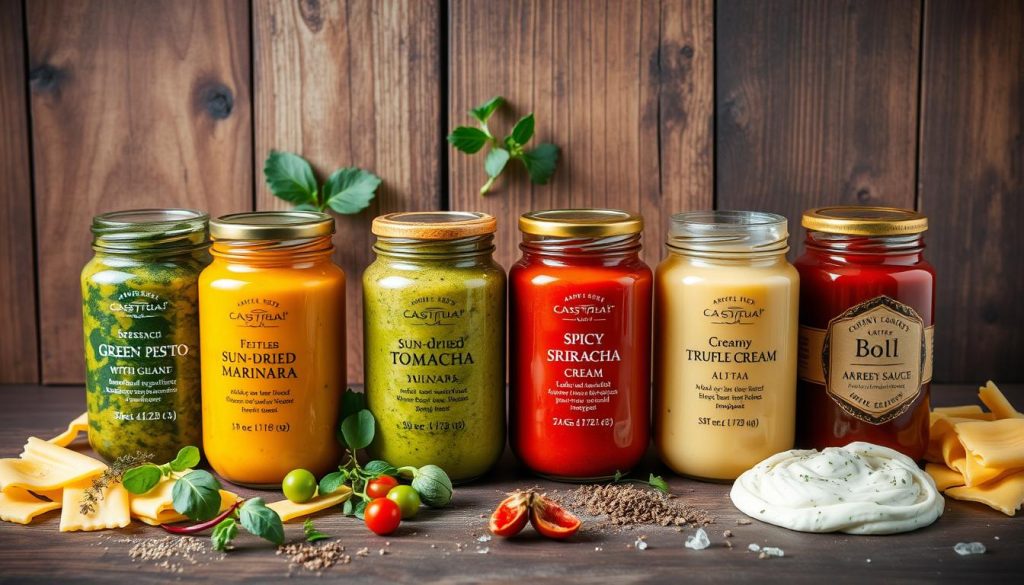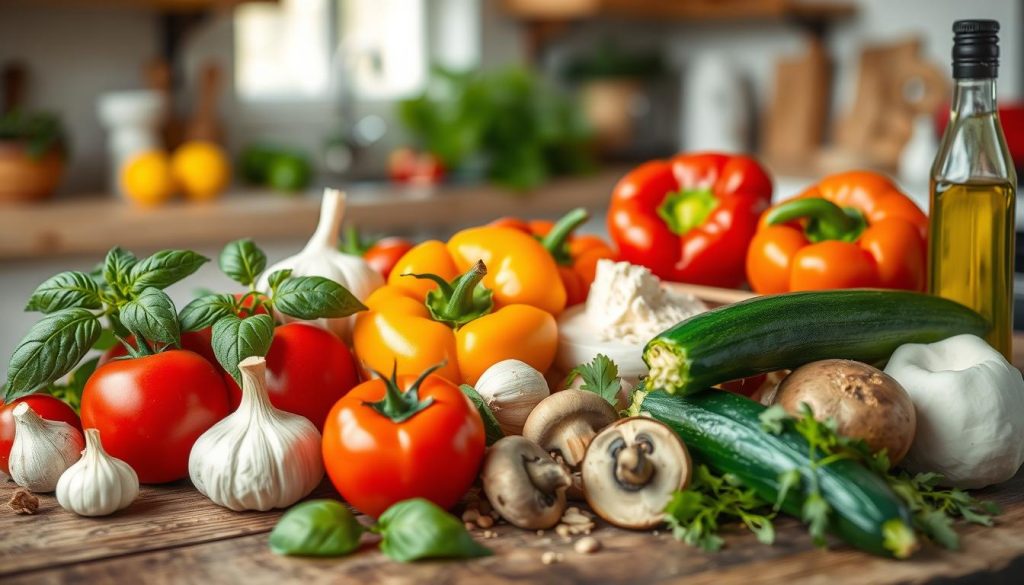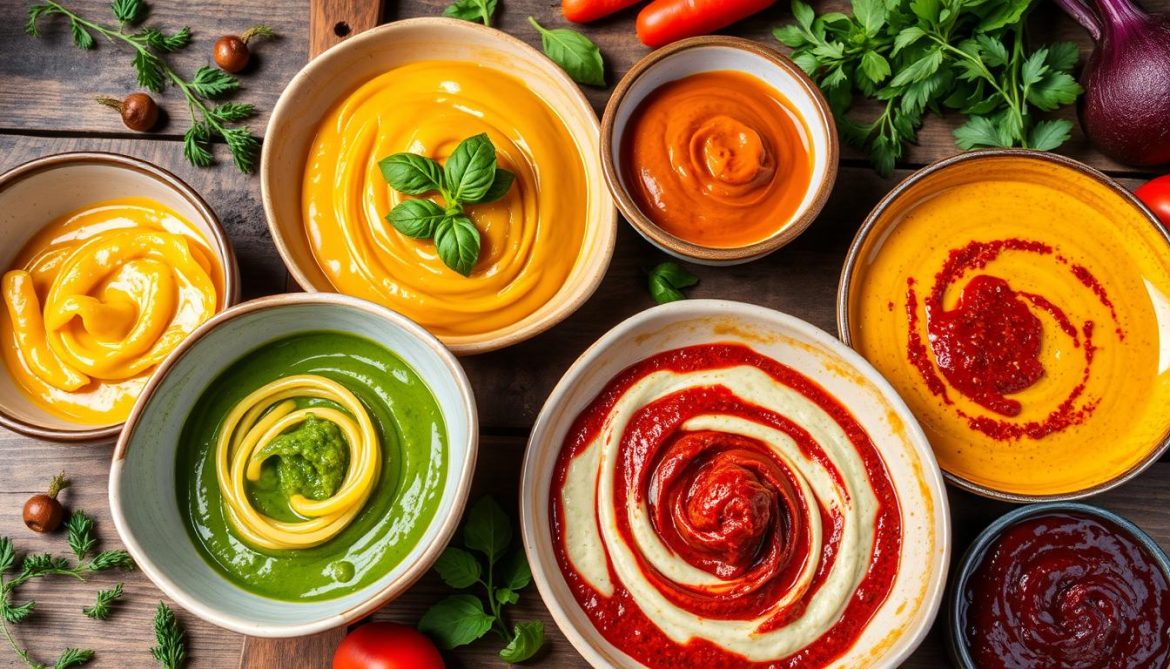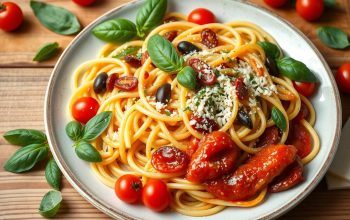I’m so excited to take you on a journey into the world of creative sauces! As a passionate home cook, you’re probably on the lookout for fresh ideas to elevate your meals. In this article, we’ll dive into the art of crafting unique sauces. I’ll share tips and tricks to impress your dinner guests. From delicious spreads to handmade sauces, we’ve got it all covered!
I absolutely love discovering and sharing creative sauces! Whether you’re searching for unique condiments or looking to create your own homemade dressings, you’re in the right place. Let’s explore the art of creative sauce-making together and enhance your pasta dishes with unique flavors!
The Art of Creative Sauces: Breaking Free from Traditional Recipes
Hey there, fellow foodies! Let’s explore the world of gourmet spreads, artisanal sauces, and flavor enhancers. I’m excited to share my knowledge with you. Together, we can become master sauce makers!
To start, it’s key to know the different sauce bases. You can mix various ingredients to create unique flavors. For instance, roasted veggies can add depth, while different spreads can make your dishes creamy.
Understanding Sauce Base Types
There are many sauce bases, like tomato, cream, and pesto. Each has its own special qualities. You can mix them with different ingredients to make your own sauces.
- Tomato base: perfect for pasta sauces, pizza sauces, and marinara sauces
- Cream base: great for creamy soups, sauces, and dips
- Pesto base: ideal for pesto sauces, dips, and spreads
Essential Equipment for Sauce Making
To make tasty sauces, you’ll need a blender, saucepan, and whisk. These tools help you mix, heat, and blend your ingredients perfectly.
Basic Techniques Every Home Chef Should Know
Learning basic techniques like reducing, emulsifying, and seasoning is key. With practice, you’ll make amazing sauces and spreads. They’ll take your dishes to the next level!
| Technique | Description |
|---|---|
| Reducing | cooking down a liquid to concentrate the flavors |
| Emulsifying | combining two or more liquids that don’t normally mix |
| Seasoning | adding salt, pepper, and other flavor enhancers to taste |
Global Influences in Modern Pasta Sauces
Exploring pasta sauces reveals a world of flavors from around the globe. From Korean chili flakes to Italian olive oil, each place brings its own twist. These specialty marinades can make your homemade dressing stand out. Let’s explore these influences and how to use them in your sauce making.
Imagine making a sauce that blends Asian stir-fries, Indian curries, and Mediterranean tastes. With a bit of creativity, you can create unique sauces that wow your loved ones. Some global influences to try include:
- Asian-style stir-fries with soy sauce, ginger, and garlic
- Indian-inspired curries with coconut milk, turmeric, and cumin
- Mediterranean flavors with olive oil, lemon juice, and oregano
These global touches can make your dressing more exciting and tasty. By mixing in marinades and flavors from different cultures, you can craft a sauce that’s truly yours. So, don’t hesitate to try new things – your taste buds will love it!
| Global Influence | Key Ingredients | Flavor Profile |
|---|---|---|
| Asian-style stir-fries | Soy sauce, ginger, garlic | Savory, umami, slightly sweet |
| Indian-inspired curries | Coconut milk, turmeric, cumin | Rich, creamy, aromatic |
| Mediterranean flavors | Olive oil, lemon juice, oregano | Bright, refreshing, herbaceous |
Essential Ingredients for Unique Sauce Creation
Hey there, fellow foodies! Let’s explore unique condiments, gourmet spreads, and flavor enhancers. These will elevate your sauce making. I’m excited to share my favorite ingredients for a twist in your sauces. Creating unique sauces means trying new flavors and ingredients.
Imagine a pantry full of unique condiments and flavor enhancers. Ingredients like lemongrass and cardamom can make your sauces special.
Unexpected Herbs and Spices
My favorite herbs and spices include lemongrass, cardamom, and smoked paprika. They add smoky, spicy, or citrusy flavors. Use them to make unique condiments like lemongrass-ginger sauce or cardamom-infused oil.
Alternative Base Ingredients
Try using cashew cream and roasted vegetables for a rich texture. They’re great for gourmet spreads like roasted vegetable hummus or cashew-based pesto.
Secret Flavor Enhancers
Now, let’s talk about secret flavor enhancers. Truffle oil, miso paste, and soy sauce add depth. They make your sauces unforgettable.
Don’t be afraid to try new ingredients and flavors. With creativity and the right ingredients, you can impress everyone. Happy cooking!
Transforming Classic Sauces into Contemporary Masterpieces
Hey there, fellow foodies! Let’s explore how to make classic sauces modern. I’m excited to share my favorite ways to update traditional sauces. You can add balsamic glaze to tomato sauce or use truffle oil for a twist.
Creating culinary creations is all about trying new things. You can mix a creamy sauce with a light homemade dressing. The goal is to have fun and experiment. Here are some tips to get you started:
- Experiment with different herbs and spices to add unique flavors to your sauces.
- Try using alternative base ingredients, such as cashew cream or roasted vegetables, to create creamy and delicious sauces.
- Don’t be afraid to add a splash of acidity, such as lemon juice or vinegar, to balance out the flavors in your sauces.
By following these tips and using your imagination, you can impress everyone with your artisanal sauces. The most important thing is to have fun. So, get creative with your sauces and share your favorite recipes with me!

Happy cooking, and I’ll see you in the next section. We’ll explore more ways to elevate your pasta game!
| Sauce | Ingredients | Flavor Profile |
|---|---|---|
| Classic Tomato Sauce | Tomatoes, garlic, olive oil | Rich and tangy |
| Truffle Oil Sauce | Truffle oil, cream, parmesan cheese | Earthy and decadent |
| Balsamic Glaze Sauce | Balsamic vinegar, olive oil, garlic | Sweet and sour |
Plant-Based Creative Sauce Alternatives
Hey there, fellow foodies! Let’s explore the world of plant-based eating. We’ll look at amazing creative sauce alternatives. As a hobby cook, I’m excited to share my favorite plant-based sauces. They’re perfect for pasta, salads, and more!
Plant-based sauces offer endless options. You can make unique condiments with nuts, seeds, and veggies. For example, a creamy sauce can be made with cashews, lemon juice, and garlic. Or, you can use roasted veggies like eggplant, zucchini, and red bell peppers for flavor.
- Nut-based cream sauces: made with nuts like cashews, almonds, or hazelnuts
- Vegetable-forward options: using roasted or sautéed vegetables like eggplant, zucchini, or mushrooms
- Protein-rich sauce innovations: using lentils, chickpeas, or tofu to add protein and texture
These sauces are not only tasty but also full of nutrients. They’re great for those who want gourmet spreads and creative sauces to make their meals better.
So, get creative and start making plant-based sauces today! With a little imagination and some basic ingredients, you can create amazing flavors. Happy cooking, and don’t forget to share your favorite plant-based sauce recipes with me!
Seasonal Ingredients for Year-Round Sauce Innovation
Hey there, fellow foodies! Let’s explore how to spice up our sauce making with seasonal ingredients. I love trying out fresh herbs in summer and root veggies in winter. This way, we can make unique homemade dressing recipes.
Using seasonal ingredients, we can craft a range of artisanal sauces that taste great and look good too. For instance, in spring, we can mix fresh asparagus and lemon for a light sauce. In fall, roasted butternut squash and sage make a cozy sauce.
Some top picks for sauce making include:
- Summer: fresh basil, mint, and cilantro
- Winter: roasted carrots, parsnips, and sweet potatoes
- Spring: fresh asparagus, lemon, and garlic
- Fall: roasted butternut squash, sage, and apple cider
We can mix these with flavor enhancers like garlic, ginger, and citrus. This way, we can make a variety of sauces.

So, let’s get creative and try out seasonal ingredients in our sauce making! With a bit of practice, you’ll soon be whipping up tasty homemade dressing and artisanal sauces like a pro. Happy cooking!
| Season | Ingredients | Sauce Ideas |
|---|---|---|
| Summer | Fresh herbs, lemon, garlic | Light and refreshing sauces, perfect for pasta or seafood |
| Winter | Root vegetables, roasted carrots, parsnips | Warm and comforting sauces, great for hearty meat dishes |
| Spring | Fresh asparagus, lemon, garlic | Light and refreshing sauces, ideal for spring vegetables and pasta |
| Fall | Roasted butternut squash, sage, apple cider | Warm and comforting sauces, perfect for fall comfort food |
Quick and Easy Creative Sauce Shortcuts
Hey there, fellow foodies! Sometimes, you need a quick sauce fix. I’ve got some amazing shortcuts for you, from five-minute sauces to make-ahead bases.
When it comes to gourmet spreads and culinary creations, I focus on simplicity and flavor. I love using specialty marinades to enhance my dishes’ taste.
Five-Minute Sauce Solutions
In a rush? No worries! Here are some fast sauce fixes that take just five minutes:
- Tomato sauce with fresh basil and garlic
- Alfredo sauce with heavy cream and parmesan cheese
- Pesto sauce with basil, garlic, and pine nuts
Make-Ahead Sauce Bases
Make your sauce bases ahead of time. It saves you time and stress later. Here are some ideas:
- Marinara sauce with canned tomatoes and herbs
- Arrabbiata sauce with crushed tomatoes and red pepper flakes
- Bechamel sauce with butter, flour, and milk
These quick sauce shortcuts will help you whip up tasty dishes fast. So, get creative and enjoy cooking with gourmet spreads, culinary creations, and specialty marinades!
| Sauce Type | Ingredients | Prep Time |
|---|---|---|
| Tomato Sauce | Tomatoes, garlic, basil | 5 minutes |
| Alfredo Sauce | Heavy cream, parmesan cheese, garlic | 5 minutes |
| Pesto Sauce | Basil, garlic, pine nuts | 5 minutes |
Pairing Your Creative Sauces with Different Pasta Types
Choosing the right pasta is key when you’re showing off your artisanal sauces. As a hobby cook, you want your unique condiments and homemade dressing to shine. Let’s look at some popular pasta types and how to pair them with your sauces.
Here are some popular pasta types and their perfect sauce pairings:
- Delicate angel hair: pairs well with light, oily artisanal sauces like pesto or carbonara
- Hearty pappardelle: pairs well with rich, meaty unique condiments like bolognese or wild boar ragu
- Classic spaghetti: pairs well with homemade dressing like tomato sauce or aglio e olio
Remember, the key to pairing pasta with sauce is to balance flavors and textures. Don’t be afraid to experiment and find your own perfect pairings!
“The right pasta can elevate your sauce from good to great. Experiment with different types and find your perfect match!”
Troubleshooting Common Sauce-Making Challenges
Hey there, fellow hobby cooks! Sauce making can be unpredictable, and sometimes things don’t go as planned . But don’t worry, I’ve got your back! We’ll tackle common sauce-making challenges and offer tips to rescue your sauces. Whether it’s texture problems or flavor imbalances, we’ll find ways to fix them.
Texture Problems and Solutions
Texture issues are common in sauces. If your sauce is too thick, add a bit more liquid like broth or cream. If it’s too thin, simmer it or add cornstarch or flour. For example, adding heavy cream to a creamy tomato sauce makes it rich and velvety.
Balancing Flavors
Getting the flavor right can be tricky. To balance your sauce, add a pinch of salt, some fresh herbs, or a squeeze of lemon juice or vinegar. Remember, a little goes a long way. Start small and taste as you go. Experiment with different ingredients to create unique flavors for your sauces and spreads.
Follow these tips to make delicious and balanced sauces. They’ll take your dishes to the next level. Happy cooking! If you have questions or need more help, don’t hesitate to reach out.
Sauce Storage Solutions and Serving Suggestions
Now that you’ve made your tasty homemade dressing and artisanal sauces, it’s time to think about storage and serving. Proper storage keeps your cultivated culinary creations fresh and flavorful. Let’s look at some practical solutions and ideas to enhance your sauce-making journey.
Here are some storage solutions and serving suggestions for your homemade dressing and artisanal sauces:
- Store your sauces in airtight containers to preserve freshness and flavor.
- Label and date your containers so you can easily keep track of what you have and how long it’s been stored.
- Consider using glass jars or containers to store your sauces, as they are non-reactive and can help preserve the flavor and quality of your cultivated culinary creations.
When it comes to serving, the possibilities are endless! You can use your homemade dressing and artisanal sauces as dips, marinades, or toppings for your favorite dishes. Get creative and have fun experimenting with different combinations and flavors.
By following these storage solutions and serving suggestions, you’ll be able to enjoy your homemade dressing and artisanal sauces for a longer period and share them with your loved ones. Happy cooking and bon appétit!
| Storage Solution | Description |
|---|---|
| Airtight Containers | Preserve freshness and flavor |
| Labeling and Dating | Keep track of stored sauces |
| Glass Jars or Containers | Non-reactive and preserve flavor and quality |
Taking Your Pasta Game to the Next Level: Beyond Basic Sauces
Congratulations, my culinary friend! You’ve mastered the art of creating delightful pasta sauces. Now, it’s time to explore gourmet spreads, specialty marinades, and other unique condiments. These will take your meals to new heights.
Imagine drizzling vibrant pesto over your favorite pasta. Or a rich, creamy cashew-based Alfredo sauce that’s dairy-free. The possibilities are endless when you think beyond traditional sauces.
To keep exploring, look for local culinary workshops or online classes. They focus on innovative pasta pairings. Learn from expert chefs and discover new techniques.
Remember, the key to great pasta is to experiment. Try new flavors and don’t be afraid to get messy. The best discoveries come from taking risks.
So, let’s raise a fork to your continued culinary adventures. The world of creative sauces and toppings is waiting. It’s ready to turn your pasta into a masterpiece.



